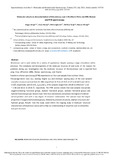JavaScript is disabled for your browser. Some features of this site may not work without it.
| dc.contributor.author | Jiang, Jingyu | |
| dc.contributor.author | Zhang, Shuo | |
| dc.contributor.author | Longhurst, Phil | |
| dc.contributor.author | Yang, Weihua | |
| dc.contributor.author | Zheng, Shaojie | |
| dc.date.accessioned | 2021-04-21T10:20:13Z | |
| dc.date.available | 2021-04-21T10:20:13Z | |
| dc.date.issued | 2021-03-22 | |
| dc.identifier.citation | Jiang J, Zhang S, Longhurst P, et al., (2021) Molecular structure characterization of bituminous coal in Northern China via XRD, Raman and FTIR spectroscopy. Spectrochimica Acta Part A: Molecular and Biomolecular Spectroscopy, Volume 255, July 2021, Article number 119724 | en_UK |
| dc.identifier.issn | 1386-1425 | |
| dc.identifier.uri | https://doi.org/10.1016/j.saa.2021.119724 | |
| dc.identifier.uri | http://dspace.lib.cranfield.ac.uk/handle/1826/16607 | |
| dc.description.abstract | Bituminous coal is used widely for a variety of applications despite causing a range of problems within processes. The complexity and heterogeneity of the molecular structure of coal is one of the reasons for problems during use. Investigation into the molecular structure of the bituminous coal is reported from using X-ray diffraction (XRD), Raman spectroscopy, and Fourier Transform infrared (FTIR) spectroscopy experiments on four coal samples from coal mines in Northern China. The average lateral sizes (La), stacking heights (Lc) and interlayer spacing (d002) of the coal samples’ crystallite structures derived from the XRD ranged from 25.78 to 27.93 Å, 17.27 to 25.88 Å and 3.40 to 3.52 Å, respectively; and the G-D1, ID1/IG and La of the samples ranged from 245.06 to 249.63 cm−1, 2.18 to 2.48 and 18.16 to 20.64 Å, respectively. The FTIR spectra reveals that coal samples incorporate oxygen-containing functional groups, aliphatic functional groups, aromatic functional groups and hydroxyl functional groups. Results show these four coal samples contained a low degree of ordered microcrystalline units with a low degree of aromatic conformation. The samples have the largest proportion of oxygenated functional groups, followed by aromatic structures, aliphatic structures and hydroxyl groups. Results from this study could inform the ongoing study of molecular structural characteristics of bituminous coal as well as help our understanding of properties such as wettability and pore structure. | en_UK |
| dc.language.iso | en | en_UK |
| dc.publisher | Elsevier | en_UK |
| dc.rights | Attribution-NonCommercial-NoDerivatives 4.0 International | * |
| dc.rights.uri | http://creativecommons.org/licenses/by-nc-nd/4.0/ | * |
| dc.subject | FTIR | en_UK |
| dc.subject | Raman spectroscopy | en_UK |
| dc.subject | XRD | en_UK |
| dc.subject | Bituminous coal | en_UK |
| dc.subject | Molecular structure | en_UK |
| dc.title | Molecular structure characterization of bituminous coal in Northern China via XRD, Raman and FTIR spectroscopy | en_UK |
| dc.type | Article | en_UK |
Files in this item
The following license files are associated with this item:
This item appears in the following Collection(s)
-
Staff publications (SWEE) [2844]

